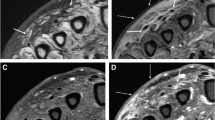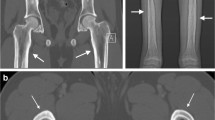Summary
We present a case report of an 18-year-old female with constant pain under the first metatarsal head. The patient showed a plantar tenderness in the area of the lateral sesamoid. The mobility of the metatarsophalangeal joint was finally restrained; blood chemistry was without pathological result. The x-ray showed a consolidation of bone structure with single areas of lyses in the left lateral sesamoid. CT and MRI presented signs of fragmentation by osteonecrosis.¶ Because of intense and duration of pain we extracted the lateral sesamoid. The histological report showed partly non-vital and partly vital compact and cancellous bone like an aseptic bone necrosis. Inflammatory infiltrates could not be detected.¶ The aseptic bone necrosis, named Morbus Renander, affects mostly young females. As a cause chronic microtraumatization or molestation are discussed.¶ Specific or unspecific sesamoiditis, osteomyelitis, fracture, osteochondritis or hyperuricaemia are differential diagnoses.¶ The existence of an sesamoideum bipartitum, tripartitum or multipartitum can aggravate to find the diagnosis. X-ray, CT, MRI and bone scan are helpful to make the diagnosis. If a conservative therapy over months brings no relief the causing sesamoid bone should be removed.
Zusammenfassung
Wir berichten von einer 18-jährigen Patientin, die persistierende Schmerzen im Bereich des linken Großzehengrundgelenkes beklagte. Klinisch zeigte sich ein plantarer Druckschmerz in Höhe des lateralen Sesambeines. Die Beweglichkeit im Großzehengrundgelenk war endgradig eingeschränkt, das Aufnahmelabor unauffällig. Röntgenbilder zeigten eine Verdichtung der Knochenstruktur mit vereinzelten Lysezonen des linken lateralen Sesambeines. CT- und Kernspinbilder zeigten Zeichen des Fragmentationsstadiums einer Osteonekrose. Aufgrund der Beschwerdedauer wurde eine Sesamoidektomie durchgeführt. Die histologische Begutachtung ergab teils avitales, teils vitales kompaktes und spongiöses Knochengewebe ohne Nachweis entzündlicher Infiltrate als Ausdruck einer aseptischen Knochennekrose.¶ Die aseptische Nekrose eines Sesambeines am Großzehengrundgelenk, welche nach dem Erstbeschreiber als Morbus Renander bezeichnet wird, betrifft vorwiegend jüngere Frauen. Als Ursache werden chronische Mikrotraumata oder Überlastungen diskutiert.¶ Differenzialdiagnostisch sind eine unspezifische oder spezifische Sesamoiditis, eine Osteomyelitis, eine Fraktur, eine Osteochondritis und eine Hyperurikämie in Erwägung zu ziehen. Das Vorliegen eines Os sesamoideum bipartitum, tripartitum oder multipartitum kann die Diagnosestellung erschweren. Diagnostisch hilfreich sind Röntgenaufnahmen, eine Computer- oder Kernspintomographie, sowie eine Szintigraphie.¶ Versagt ein mehrmonatiger konservativer Therapieversuch sollte das betroffene Sesambein entfernt werden.
Similar content being viewed by others
Author information
Authors and Affiliations
Additional information
Eingegangen: 27. März 2003/Akzeptiert: 15. April 2003
Correspondence to:Markus Kalweit
Rights and permissions
About this article
Cite this article
Kalweit, M., Frank, D. Die aseptische Nekrose des Sesambeines am Metatarsale I – (Morbus Renander) –. FussSprung 1, 0148–0151 (2003). https://doi.org/10.1007/s10302-003-0039-3
Issue Date:
DOI: https://doi.org/10.1007/s10302-003-0039-3




